Sony HXR-MC2500 Operating Guide
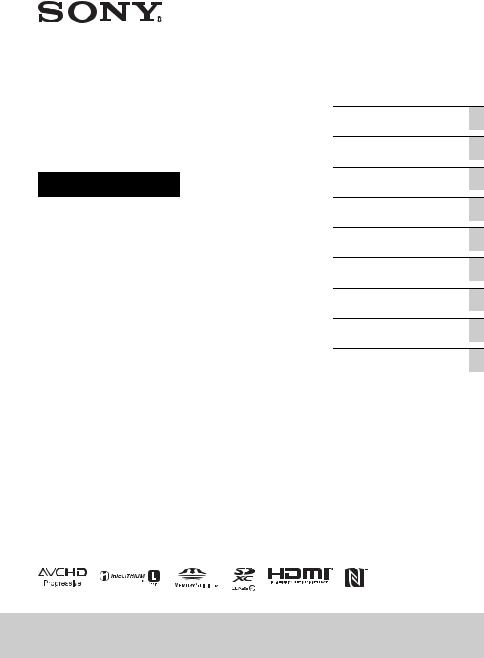
Solid-State Memory
Camcorder
Operating Guide
4-549-534-11(1)
Table of Contents
Getting Started
Recording
Playback
Editing
Using the Menu
Connecting with another device
Troubleshooting
Additional Information
HXR-MC2500

Read this first
Before operating this unit, please read this manual thoroughly, and retain it for future reference.
Notes on use
Using the camcorder
•Do not hold the camcorder by the following parts, and also do not hold the camcorder by the jack covers.
Lens hood |
LCD screen |
On the LCD screen and lens
•A menu item that is grayed out is not available under the current recording or playback conditions.
•The LCD screen is manufactured using extremely high-precision technology, so over 99.99% of the pixels are operational for effective use. However, there may be some tiny black points and/or bright points (white, red, blue, or green in color) that appear constantly on the LCD screen. These points are normal results of the manufacturing process and do not affect the recording in any way.
Microphone Viewfinder
Panel EVF block |
Battery pack |
b Notes
•The camcorder is not dustproof, dripproof or waterproof. See “About handling of your camcorder” (p. 100).
•When connecting the camcorder to another device with communication cables, be sure to insert the connector plug in the correct way. Pushing the plug forcibly into the terminal will damage the terminal and may result in a malfunction of the camcorder.
•Use the camcorder in accordance with the regulations of a place where you use it.
White, red, blue or green point
Black point
On sunlight
•Do not record the sun or leave the camcorder under the sun for a long time. The internal parts of the camcorder may be damaged. If sunlight is focused on a nearby object, it may cause a fire.
•Do not expose your camcorder’s viewfinder, lens, or LCD screen to the sun or strong light source for extended periods. Doing so may cause a malfunction of the camcorder.
•Do not attempt to record the sun directly. Doing so may cause a malfunction of the camcorder.
2
On the temperature of your camcorder and battery pack
Your camcorder has a protective function that disables recording or playback if the temperature of your camcorder or battery pack is beyond the safely operable range. In this case, a message appears on the LCD screen or in the viewfinder (p. 89).
On recording
•In order to stabilize memory card operation, it is recommended that you format the memory card when you use it with your camcorder for the first time. All data recorded on the memory card will be erased by formatting, and cannot be recovered. Save important data on the memory card on other media such as a computer, before formatting the memory card.
•Before starting to record, test the recording function to make sure the picture and sound are recorded without any problems.
•Compensation for the loss of the content of recordings or the loss of recording opportunities cannot be provided, even if recording or playback is not possible due to a malfunction of the camcorder, storage media, etc., or even if images or sounds are distorted due to the limits of the capabilities of the camcorder.
•TV color systems differ depending on the countries/regions. To view your recordings on a TV, a TV of the appropriate color system for the country/ region is required.
•Television programs, films, video tapes, and other materials may be copyrighted. Unauthorized recording of such materials may be contrary to the copyright laws.
•Because of the way that the image device (CMOS sensor) reads out image signals, the following phenomena may occur.
–The subjects passing by the frame rapidly might appear crooked depending on the recording conditions. (This phenomenon may
be notable in displays having high motion resolution.)
–Horizontal lines appear on the LCD screen during recording under fluorescent lights, sodium lamps or mercury lamps. The phenomena can be reduced by adjusting the shutter speed (p. 35).
Save all your recorded image data
•To prevent your image data from being lost, save all your recorded images on external media periodically. To save images on an external device, see page 79.
To handle the recorded images on your computer
Download the dedicated application software (p. 16).
Format the recording media using [MEDIA FORMAT] if images are not recorded or played back properly
If you continue recording and deleting images on recording media for a long period of time, the files on that recording media may be fragmented. As a result, you may not be able to record and save images properly. If this happens, save images on a PC, then format the recording media
(p. 59).
Continued , 3
Read this first (Continued)
About the operation of the camcorder
You can operate the camcorder using the V/v/B/b/SET button (p. 61).
About this manual
•The on-screen displays in each local language are used for illustrating the operating procedures. Change the screen language before using your camcorder if necessary (p. 77).
•Design and specifications of recording media and other accessories are subject to change without notice.
•The screen displays used in this manual are those of the PAL model.
See the bottom of the camcorder to confirm whether it is NTSC or PAL system.
4
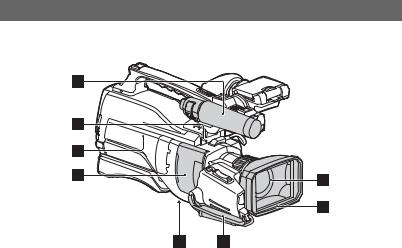
Identifying parts and controls
Body
The numbers in ( ) are reference pages.
AMicrophone
BMIC jack (PLUG IN POWER) (70)
C  (N mark)
(N mark)
•Touch an NFC-enabled smartphone to the mark to establish a connection with the camcorder.
•Near Field Communication (NFC) is an international standard for short-range wireless communication technology.
DSlide cover (22)
ELens (G Lens)
FLens hood
GGrip belt
HTripod receptacle
Attach the tripod (sold separately: the length of the screw must be less than 5.5 mm (7/32 in.)) to the tripod receptacle using a tripod screw.
Continued , 5

Identifying parts and controls (Continued)
ALight switch
BMulti Interface shoe (67)
CVideo light (38)
DAccessory shoe
ESpeaker
FASSIGN1/PEAKING button (46, 71)
GMANUAL button (28)
HWHT BAL button (36)
IWB SET button (37)
Attaching the lens hood
Align the marks on the lens hood to those on the camcorder, and turn the lens hood in the direction of the arrow 2 until it is locked.
6

Removing the lens hood
•Turn the lens hood cover in the direction of the arrow as illustrated while pressing the lever on the lens hood cover.
z Tips
•If you attach or remove a 62 mm (2 1/2 in.) PL filter or MC protector, remove the lens hood.
Continued , 7
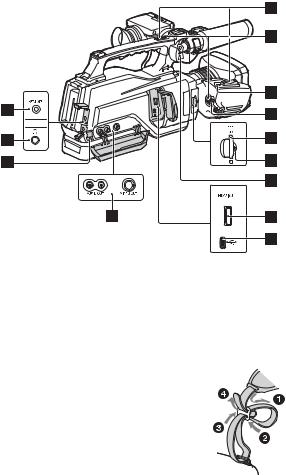
Identifying parts and controls (Continued)
AREMOTE jack
The REMOTE jack is used for controlling the playback of video devices and peripherals connected to it.
Bi (Headphone) jack
CCable holder
The cable holder is used for fixing the A/V connecting cable, etc.
DPower zoom lever (27)
EREC START/STOP button (23)
FASSIGN 2/FOCUS MAGNIFIER button (46)
GON/STANDBY switch (19)
HMemory card slot (22)
IAccess lamp (24)
JMIC cable holder
KHDMI OUT jack (Output only) (53) The available video signals are read, and the appropriate output format is selected and output automatically.
L (USB) jack (mini-AB) (Output only)
(USB) jack (mini-AB) (Output only)
MAUDIO OUT/VIDEO OUT jack (81)
To attach a shoulder strap
Attach a shoulder strap (sold separately) to the hooks for a shoulder strap.
8
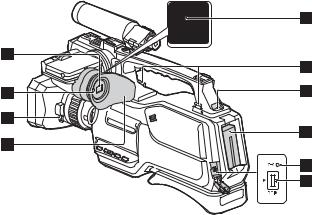
AViewfinder (21)
BEye sensor (74)
CLens hood release lever (7)
DEyecup (21)
EViewfinder lens adjustment lever (21)
FHook for the Shoulder belt Attach the Shoulder belt (sold separately).
GBATT (battery) RELEASE button (18)
HBattery pack (17)
ICHG (charge) lamp (17)
JDC IN jack (17)
Continued , 9

Identifying parts and controls (Continued)
ALCD screen (21)
BV/v/B/b/SET buttons
CTHUMBNAIL button (48)
DMENU button
EManual ring (33)
10
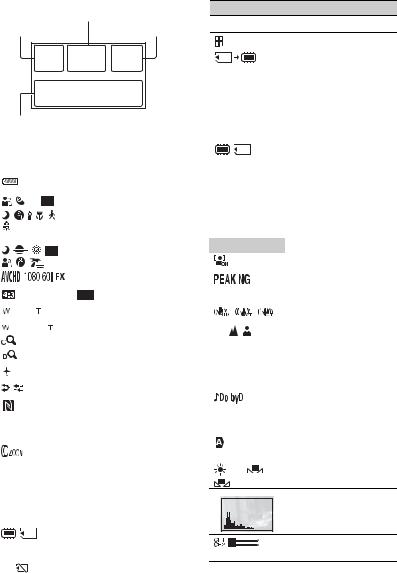
Screen indicators
|
Center |
Upper left |
Upper right |
Bottom
Upper left
Indicator |
|
Meaning |
||||||
100% |
|
Remaining battery |
||||||
|
|
|
|
|
|
|
|
|
. |
|
|
|
INTELLIGENT AUTO |
||||
|
|
|
|
|
|
|
|
(face detection/scene |
|
|
|
|
|
|
|
|
detection/camera-shake |
|
|
|
|
|
|
|
||
|
|
|
|
|
|
|
|
detection) (38) |
|
|
|
|
|
|
|
||
|
|
|
|
|
|
|
|
|
|
|
|
|
|
|
|
|
SCENE SELECTION |
|
|
|
|
|
|
|
(39) |
|
|
|
|
|
|
|
|
|
|
|
|
|
|
|
|
|
|
REC FORMAT (31) |
|
|
|
|
|
|
|
|
|
|
|
|
|
|
|
|
|
|
|
|
|
|
|
|
|
|
WIDE REC (68) |
|
|
|
|
|
|
|
|
|
|
|
|
|
|
|
|
|
Optical zoom |
|
|
|
|
|
|
|
|
|
|
|
|
|
|
|
|
|
|
|
|
|
|
|
|
|
|
Clear image zoom |
|
|
|
|
|
|
|
|
|
×1.2 |
|
|
|
Digital zoom |
||||
×2.3 |
|
|
|
|||||
|
|
|
|
|
|
|
|
|
|
|
|
|
|
|
|
|
AIRPLANE MODE (76) |
|
|
|
|
|
|
|
|
|
|
|
|
|
|
|
|
|
SIMUL/RELAY REC |
|
|
|
|
|
|
|
|
|
|
|
|
|
|
|
|
|
NFC active |
|
|
|
|
|
|
|
|
|
100-0001 |
|
|
Playback folder of |
|||||
|
|
|
|
|
|
|
|
memory card |
|
|
|
|
|
|
|
|
|
|
|
|
|
|
|
|
|
Zoom function is |
|
|
|
|
|
|
|
|
assigned to the Manual |
|
|
|
|
|
|
|
|
ring (27) |
|
|
|
|
|
|
|
|
|
Center |
|
|
||||||
|
|
|
|
|
|
|
|
|
Indicator |
|
Meaning |
||||||
|
|
|
|
|
|
|
|
Recording media |
|
|
|
|
|
|
|
|
|
REC STBY |
|
Recording status (23) |
||||||
|
|
|
|
|
|
|
|
|
E |
|
Warning (89) |
||||||
|
|
|
|
|
|
|
|
|
Indicator Meaning
NPlayback indicator (48)
|
|
|
|
|
|
|
Processing |
|
|
|
|
|
|
|
|
|
|
|
|
|
|
|
|
|
|
|
|
|
|
|
Relay recording |
|
|
|
|
|
|
|
|
Upper right |
|
||||||
|
|
|
|
|
|
|
|
Indicator |
|
Meaning |
|||||
0min |
|
Estimated remaining |
|||||
|
|
|
|
|
|
|
recording time |
|
|
|
|
|
|
|
|
|
|
|
|
|
|
|
Recording/playback |
|
|
|
|
|
|
|
media |
|
|
|
|
|
|
|
|
00:00:00:00 |
Time code |
||||||
|
|
|
|
|
|
|
(hour:minute:second: |
|
|
|
|
|
|
|
frame) |
|
|
|
|
|
|
|
|
Bottom |
|
|
|||||
|
|
|
|
|
|
|
|
Indicator |
|
Meaning |
|||||
|
|
|
|
|
|
|
Face detection [ON] |
|
|
|
|
|
|
|
|
|
|
|
|
|
|
|
PEAKING (71) |
|
|
|
|
|
|
|
|
|
|
|
|
|
|
|
|
|
|
|
|
|
|
|
ZEBRA (71) |
|
|
|
|
|
|
|
|
|
|
|
|
|
|
|
STEADYSHOT (66) |
|
|
|
|
|
|
|
|
9 |
|
|
|
Manual focus (28) |
|||
|
|
|
|
|
|
|
|
F3.5 |
|
Iris (34) |
|||||
|
|
|
|
|
|
|
|
9dB |
|
Gain (34) |
|||||
|
|
|
|
|
|
|
|
100 180° |
|
Shutter speed (35) |
|||||
|
|
|
|
|
|
|
|
|
|
|
|
|
|
|
AVCHD AUDIO |
|
|
|
|
|
|
|
|
|
|
|
|
|
|
|
FORMAT (69) |
|
|
|
|
|
|
|
|
-2.0EV |
|
AE SHIFT (66) |
|||||
|
|
|
|
|
|
|
|
|
|
|
|
|
|
|
Auto setting/manual |
|
|
|
|
|
|
|
setting (72) |
|
|
|
|
|
|
|
|
|
|
|
|
n |
A |
White balance (36) |
|
B
HISTOGRAM (70)
AUDIO LEVEL
DISPLAY (72)
Continued , 11

Screen indicators (Continued)
Indicator Meaning
MI SHOE VIDEO
LIGHT (67)
REC LEVEL MODE (69)
MIC SELECT (70)
z Tips
•Indicators may look different or appear at different positions.
Data code during recording
The recording date, time and condition are recorded automatically on the recording media. They are not displayed while recording. However, you can check them by selecting  (DISPLAY SET) t [DATA CODE] and choosing the data that you want to display, or by pressing the ASSIGN button to which the DATA CODE function is assigned, during playback
(DISPLAY SET) t [DATA CODE] and choosing the data that you want to display, or by pressing the ASSIGN button to which the DATA CODE function is assigned, during playback
(p. 51).
12

Table of Contents |
|
Read this first ........................................................................................... |
2 |
Identifying parts and controls ................................................................... |
5 |
Body...................................................................................................... |
5 |
Screen indicators .................................................................................... |
11 |
Getting Started |
|
Step 1: Checking supplied accessories .................................................. |
16 |
Step 2: Charging the battery pack .......................................................... |
17 |
Step 3: Turning on the camcorder and setting the date and time .......... |
19 |
Setting the date and time.................................................................... |
19 |
Step 4: Adjusting the LCD screen and viewfinder .................................. |
21 |
Step 5: Preparing the recording media ................................................... |
22 |
Contents of Table
Recording |
|
Recording ............................................................................................... |
23 |
Recording movies ............................................................................... |
23 |
Changing the setting of the REC START/STOP button and handle REC |
|
START/STOP button............................................................................ |
25 |
Adjusting the zoom ............................................................................. |
27 |
Adjusting the focus ................................................................................. |
28 |
Using the Focus magnifier .................................................................. |
29 |
Focusing on a detected face (Face detection)................................... |
29 |
Changing the recording setting .............................................................. |
31 |
Selecting the recording format ........................................................... |
31 |
Setting the DV MODE (DV mode) ....................................................... |
31 |
Assigning frequently-used menu items to the Manual ring ..................... |
33 |
Adjusting the brightness ......................................................................... |
34 |
Adjusting the iris ................................................................................. |
34 |
Adjusting the gain ............................................................................... |
34 |
Adjusting the shutter speed................................................................ |
35 |
Adjusting the exposure ....................................................................... |
36 |
Adjusting the color tone .......................................................................... |
36 |
Adjusting the white balance................................................................ |
36 |
Useful functions ...................................................................................... |
38 |
Recording movies in dim places (Video light) .................................... |
38 |
Using the video light diffuser .............................................................. |
38 |
Selecting the suitable setting automatically for the recording situation |
|
(AUTO MODE SET) ............................................................................. |
38 |
What you can do with the Wi-Fi function of the camcorder ................ |
39 |
Downloading “Content Browser Mobile”............................................. |
40 |
Connecting the camcorder to an Android smartphone equipped with |
|
the NFC function using One-touch ..................................................... |
40 |
Continued , 13 |
|

Table of Contents (Continued) |
|
Using a smartphone as a remote controller ........................................ |
41 |
Connecting without using the NFC function (Android)........................ |
42 |
Connecting without using the NFC function (iPhone/iPad) ................. |
43 |
Setting time data ................................................................................. |
44 |
Reviewing the most recently recorded scene |
|
(LAST SCENE REVIEW)....................................................................... |
45 |
Assigning the functions to the ASSIGN buttons ..................................... |
46 |
Playback |
|
Playback ................................................................................................ |
48 |
Playing back movies ........................................................................... |
48 |
Changing/checking the settings in your camcorder ............................... |
51 |
Changing the screen display .............................................................. |
51 |
Displaying recording data (DATA CODE)........................................... |
51 |
Connecting a monitor or a TV ................................................................ |
53 |
Editing |
|
Protecting movies (Protect) .................................................................... |
56 |
Dividing a movie ..................................................................................... |
57 |
Deleting movies ..................................................................................... |
58 |
Formatting the recording media ............................................................. |
59 |
Deleting all data from the memory card and internal memory ............... |
59 |
Repairing the image database file ......................................................... |
60 |
Using the Menu |
|
Operating the menu ............................................................................... |
61 |
Menu items ............................................................................................ |
63 |
(CAMERA SET) menu .................................................................... |
65 |
Settings to adjust your camcorder to the recording conditions |
|
(STEADYSHOT, etc.) |
|
(REC/OUT SET) menu .................................................................... |
68 |
Recording settings, input and output settings (REC SET/VIDEO OUT, etc.)
(AUDIO SET) menu ........................................................................... |
69 |
Settings for the audio recording (AVCHD AUDIO FORMAT, etc.)
(DISPLAY SET) menu ..................................................................... |
70 |
Display settings (MARKER/DISPLAY OUTPUT, etc.) |
|
(TC/UB SET) menu ......................................................................... |
74 |
Time code settings (TC PRESET/UB PRESET/TC FORMAT, etc.) |
|
14

(NETWORK SET) menu ................................................................... |
76 |
Settings for the Wi-Fi function (CTRL W/SMARTPHONE, etc.)
(OTHERS) menu .............................................................................. |
77 |
Settings while recording or other basic settings (AREA SET/BEEP, etc.)
Connecting with another device |
|
Saving images on an external media device |
..........................................79 |
Creating a standard definition image quality (DV) disc with a recorder, etc. |
|
.................................................................................................... |
81 |
Troubleshooting |
|
Troubleshooting ...................................................................................... |
83 |
Warning indicators and messages ......................................................... |
89 |
Additional Information |
|
Recording time of movies ....................................................................... |
93 |
Using your camcorder abroad ................................................................ |
95 |
File/folder structure on the recording media ........................................... |
96 |
Maintenance and precautions ................................................................ |
97 |
About the AVCHD format .................................................................... |
97 |
About the memory card ...................................................................... |
97 |
About the “InfoLITHIUM” battery pack ............................................... |
98 |
About handling of your camcorder ................................................... |
100 |
Specifications ....................................................................................... |
102 |
Index ..................................................................................................... |
107 |
Contents of Table
15

Getting Started
Step 1: Checking supplied accessories
Make sure that you have following items supplied with your camcorder.
The number in the parentheses indicates the number of that item supplied.
Recording media are sold separately.
AC Adaptor (AC-L100C) (1) (p. 17)
Power cord (mains lead) (1) (p. 17)
USB adaptor cable (1)
Rechargeable battery pack (NP-F570) (1)
Eyecup (1) (p. 21)
Lens hood (1) (p. 6)
Microphone (1)
Wind screen (1)
Lens cap (1)
Video light diffuser (1)
Shoe cap (1) (attached on the camera)
CD-ROM “Manuals for Solid-State Memory Camcorder” (1)
Operating Guide (2)
Software Downloads
When the unit is used with a PC connection, download device drivers, plugins, and application software, where applicable, from the Sony Professional products web site.
Sony Professional products web site
homepage: |
|
U.S.A. |
http://pro.sony.com |
Canada |
http://www.sonybiz.ca |
Latin America |
http://sonypro-latin.com |
Europe, Middle East and Africa http://www.pro.sony.eu http://www.sonybsc.com http://pro.sony-asia.com http://bp.sony.co.kr http://pro.sony.com.cn
Although the data regarding recorded materials are stored over multiple files and folders, you can easily handle the clips without considering its data and directory structure, by using the dedicated application software.
16

Step 2: Charging the battery pack
You can charge the “InfoLITHIUM” |
3 Connect the AC Adaptor and |
battery pack (L series) with the supplied |
|
AC Adaptor. |
power cord from the camcorder |
b Notes |
to an outlet. |
|
•You can use a large capacity battery pack, NP970 (sold separately), with your camcorder.
1 Slide the ON/STANDBY switch to
1 (STANDBY) (default setting).
2 Attach the battery pack to your camcorder.
Attach the battery pack by sliding it in the direction of the arrow while pressing it until it clicks.
Battery
DC IN jack
 DC plug
DC plug
To the outlet
 AC Adaptor Power cord
AC Adaptor Power cord
(mains lead)
•The CHG lamp lights up and charging starts.
•The CHG lamp turns off when the battery is fully charged. Disconnect the AC Adaptor from the DC IN jack.
Charging time
Approximate time (minute) required when you charge a fully discharged battery pack.
Battery pack |
Full charge time |
NP-F570 250
Started Getting
Continued , 17
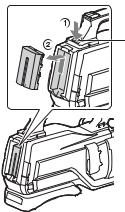
Step 2: Charging the battery pack (Continued)
Using an outside power source
You can use the AC Adaptor to obtain the AC power. While you are using the AC Adaptor, the battery pack will not lose its charge even when it is attached to your camcorder.
Follow the procedure from 1 to 2 as shown in “Step 2: Charging the battery pack” on page 17.
To store the battery pack
If the battery pack is not in use for a while, run down the battery and store it (p. 99).
To remove the battery pack
Slide the ON/STANDBY switch to 1 (STANDBY). Push the BATT (battery) RELEASE button (1) and remove the battery pack (2).
BATT (battery) RELEASE button
On the battery pack
•Turn the power off before changing the battery pack.
•The CHG lamp flashes during charging under the following conditions.
–The battery pack is not attached correctly.
–The battery pack is damaged.
–The battery pack is worn-out.
On the AC Adaptor
•Do not short-circuit the DC plug of the AC Adaptor or battery terminal with any metallic objects. This may cause a malfunction.
18

Step 3: Turning on the camcorder and setting the date and time
Turning on the camcorder
Slide the ON/STANDBY switch to ?
(ON) while pressing the green button.
When you use your camcorder for the first time, the [CLOCK SET] screen appears.
To turn off the power
Slide the ON/STANDBY switch to 1 (STANDBY).
b Notes
Setting the date and time
Set the date and time when you use your camcorder for the first time.
z Tips
•If you do not use your camcorder for about 3 months, the built-in rechargeable battery gets discharged and the date and time settings may be cleared from the memory. In that case, charge the rechargeable battery and then set the date and time again. See “Charging the preinstalled rechargeable battery” (p. 101).
LCD screen
When you set the date and time again, press the MENU button, and select
 (OTHERS) t [CLOCK SET].
(OTHERS) t [CLOCK SET].
1 Select your area by pressing the V/v/B/b button, then press the
SET button.
•If warning messages appear on the LCD screen, follow the instructions.
Started Getting
Continued , 19

Step 3: Turning on the camcorder and setting the date and time (Continued)
2 Set [SUMMERTIME], [Y] (year), [M] (month), [D] (day), hour and minute, by pressing the V/v/B/b button, then press the SET button.
The clock starts.
•Set [SUMMERTIME] to [ON] to move the time forward 1 hour.
•You can set any year up to the year 2037.
•Midnight is indicated as 12:00 AM, and noon as 12:00 PM (NTSC model).
z Tips
•The date and time are automatically recorded on the selected recording media, and can be displayed during playback (DATA CODE,
p. 51).
20

Step 4: Adjusting the LCD screen and viewfinder
Using the LCD screen
The LCD screen can be rotated in the range as illustrated below, allowing a person other than the camera operator to see the image.
Open 180 degrees.
90 degrees (max.)
180 degrees  (max.)
(max.)
When the picture in the viewfinder is hard to see
If you cannot see the picture in the viewfinder clearly under bright circumstances, use the supplied eyecup. To attach the eyecup, stretch it slightly and fit it over the groove of the eyecup attached to the camcorder. You can attach the eyecup facing either the right or left side.
Eyecup (supplied)
Adjusting the viewfinder
Pull out the LCD panel block to adjust the position (1), and rotate the viewfinder to the best angle (2, maximum of 90 degrees).
If the viewfinder image appears blurred, turn the viewfinder lens adjustment lever at the right of the viewfinder until the image is sharp.
b Notes
• Do not remove the pre-attached eyecup.
Lens adjustment lever
Started Getting
21

Step 5: Preparing the recording media
Types of memory cards you can use in your camcorder
Capacity (operation verified)
“Memory Stick PRO Duo” media (Mark2)*1
|
|
32 GB |
|
“Memory Stick PRO- |
|||
|
|
||
HG Duo” media*1 |
|
|
|
“Memory Stick XC-HG |
|
|
|
Duo” media |
|
|
|
|
|
|
|
SD memory card*2 |
|
64 GB |
|
SDHC memory card*2 |
|
|
|
SDXC memory card*2 |
|
|
*1 Described as “Memory Stick PRO Duo” media in this manual.
*2 Described as SD card in this manual.
b Notes
•Operation with all memory cards is not assured.
•“Memory Stick PRO Duo” media, half the size of “Memory Stick” media, or standard size SD cards can be used for this camcorder.
•Use an SD card of Class 4 or faster. For standard image quality (DV) recording, use an SD card of Class 6 or faster, or an SD card of Class 10 or faster.
•During the standard image quality (DV), images cannot be recorded on “Memory Stick PRO Duo” media.
•Do not attach a label or the like on memory card or memory card adaptor. Doing so may cause a malfunction.
•See page 93 for the recordable time of memory cards.
format screen appears, do not perform the format. All the data recorded will be lost.
Open the cover, and insert the memory card with the notched edge in the direction as illustrated until it clicks into place.
Close the cover after inserting the memory card.
Memory card slot
Note the direction of the notched corner
•If you insert a memory card into the slot in the wrong direction, the memory card, the memory card slot, or image data may be damaged.
•Movies recorded on “Memory Stick XC-HG Duo” media or SDXC memory cards can be imported to or played back on other equipment, such as a computer or A/V device, by connecting the camcorder to the equipment with the USB cable. However, the equipment must support the exFAT file system used for “Memory Stick XC-HG Duo” media and SDXC memory cards. Confirm in advance that the connecting equipment is supporting the exFAT file system. If you connect equipment not supporting the exFAT file system and the
To eject the memory card
Open the cover and lightly push the memory card in once.
b Notes
•If [The image database file is corrupted. The media must be restored to use again.] appears, format the memory card (p. 59).
•When inserting or ejecting the memory card, be careful of the memory card popping out and dropping.
•Do not open the cover during recording.
22

Recording
Recording
LCD screen
REC START/STOP button (on the handle)
REC START/STOP button
Recording movies
Your camcorder records movies on a memory card and the internal memory. The factory setting of recording movies is AVCHD. Do the following steps to record movies.
1 Press the latches on both sides of the lens cap and remove it.
Recording
Continued , 23
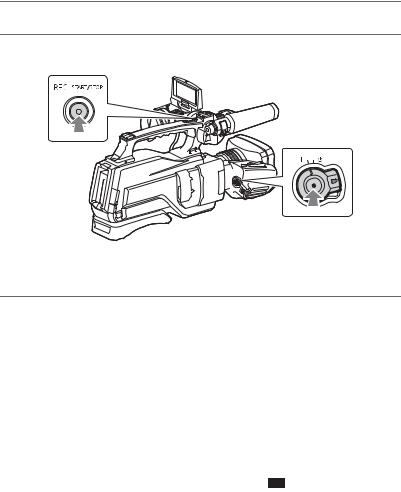
Recording (Continued)
2 Slide the ON/STANDBY switch to ? (ON) while pressing the green button.
3 Press either of the REC START/STOP button.
The recording lamps light up during recording.
To stop the movie recording, press the REC START/STOP button again.
b Notes
•When the access lamp is lit or flashing in red, your camcorder is reading or writing data on recording media. Do not shake or apply strong force to your camcorder, do not turn the power off, and do not remove the recording media, battery pack or the AC Adaptor. The image data may be destroyed.
•See page 93 on the recording time of movies.
•Your camcorder can record a movie for about 13 hours continuously.
•If a movie file size exceeds 2 GB while recording in DV or AVCHD format, the camcorder automatically divides the file and creates a new one.
•The menu settings saved when you turn the camcorder off. The access lamp lights up while the settings are being stored. If you remove the battery pack or the AC Adaptor before turning off the power, the settings may return to the default settings.
z Tips
•When recording at a setting other than standard image quality (DV), the aspect ratio is fixed to 16:9. When recording in DV mode, you can switch the aspect ratio to 4:3 ([ WIDE REC], p. 68).
WIDE REC], p. 68).
•You can change the screen display during recording (p. 51).
•Indicators displayed on the LCD screen during recording are shown on page 11.
•The recording lamps can be set to stay off ([REC LAMP], p. 77).
24

To continue recording, from a memory card to the internal memory (Relay recording)
Insert a memory card, so the camcorder switches to the internal memory just before space on the memory card runs out, and continues recording in the internal memory automatically without pausing.
Press MENU t Select  (REC/OUT SET) t [REC SET] t [SIMUL/RELAY REC] t [RELAY REC] with the V/v/B/b/SET button.
(REC/OUT SET) t [REC SET] t [SIMUL/RELAY REC] t [RELAY REC] with the V/v/B/b/SET button.
Small space
Start
REC: Recording
End
b Notes
•If you start recording in the internal memory , the camcorder does not relay recording. To perform relayrecording, start recording in the memory card.
•Seamless playback of relay-recorded movies with this camcorder is not possible.
•You can re-combine relay-recorded movies using the dedicated application software (p. 16).
To record movies using both the internal memory and memory card (Simultaneous recording)
You can record movies on both of these recording media simultaneously.
Press MENU t select 
 (REC/OUT SET) t [REC SET] t [SIMUL/RELAY REC] t [SIMULTANEOUS REC] with the V/v/B/b/SET button.
(REC/OUT SET) t [REC SET] t [SIMUL/RELAY REC] t [SIMULTANEOUS REC] with the V/v/B/b/SET button.
Changing the setting of the REC START/STOP button and handle REC START/STOP button
You can start and stop recording in different recording media at different timing by operating the both REC START/STOP button.
In the default setting, movies are recorded on both the internal memory and memory card at the same time when either record button is pressed.
•REC BUTTON: 

•HANDLE REC BUTTON: 

Recording
Continued , 25

Recording (Continued)
To change the setting
Press MENU t select 
 (REC/OUT SET) t [REC SET] t [REC BUTTON SET] with the V/v/B/b/SET button.
(REC/OUT SET) t [REC SET] t [REC BUTTON SET] with the V/v/B/b/SET button.
REC BUTTON SET |
Button and recording media |
REC BUTTON: |
Recording in both the memory card and the internal memory |
HANDLE REC BUTTON: |
starts and stops at the same time when either REC START/STOP |
|
button is pressed. |
|
|
REC BUTTON: |
Recording in the internal memory starts and stops when the REC |
HANDLE REC BUTTON: |
START/STOP button is pressed, and on the memory card when |
|
the REC START/STOP button (on the handle) is pressed. |
|
|
REC BUTTON: |
Recording in the memory card starts and stops when the REC |
HANDLE REC BUTTON: |
START/STOP button is pressed, and on the internal memory |
|
when the REC START/STOP button (on the handle) is pressed. |
|
|
26

Adjusting the zoom
Adjusting the zoom with the power zoom lever
Press the power zoom lever A or C. Press the power zoom lever C slightly for a slower zoom. Press it further for a faster zoom.
You cannot change the zoom speed of the power zoom lever A on the handle.
z Tips
•When focusing, the minimum distance required between the camcorder and the subject is about 1 cm (about 13/32 in.) for wide angle and about 80 cm (about 2 5/8 feet) for telephoto.
•The focus may not be adjusted at certain zoom positions if the subject is within 80 cm (about 2 5/8 feet) from your camcorder.
•Be sure to keep your finger on the power zoom lever A/C. If you move your finger off the power zoom lever A/C, the operation sound of the power zoom lever may also be recorded.
Adjusting the zoom with the Manual ring
If you set the RING SETTING to ZOOM, you can adjust the zoom by rotateing the Manual ring B (p. 33).
b Notes
•Turn the Manual ring B at a moderate speed. If you turn it too fast, the zoom speed may lag behind the Manual ring rotation speed, or the operation sound of the zoom may also be recorded.
Recording
Wide view: |
Close view: |
(Wide angle) |
(Telephoto) |
27

Adjusting the focus
You can adjust the focus manually for different recording conditions.
Use this function in the following cases.
–To record a subject behind a window covered with raindrops.
–To record horizontal stripes.
–To record a subject with little contrast between the subject and its background.
–When you want to focus on a subject in the background.
– To record a stationary subject using a tripod.
1 Assign the focus function to the Manual ring A (p. 33).
2 During recording or standby, press the MANUAL button B to set the focus to manual.
9 appears on the LCD screen.
3 Rotate the Manual ring A to focus on.
9 changes to  when the focus cannot be adjusted any farther. 9 changes to
when the focus cannot be adjusted any farther. 9 changes to  when the focus cannot be adjusted any closer.
when the focus cannot be adjusted any closer.
To restore automatic adjustment
Press the MANUAL button B to set the focus to automatic.
9 disappears and the automatic focus adjustment is restored.
z Tips
•The focal length information (the distance at which the subject is in focus; for when it is dark and hard to adjust the focus) appears for about 3 seconds in the following cases.
–When you press the MANUAL button B to set the focus to manual and 9 appears on the LCD screen.
–When you rotate the Manual ring Awhile 9 is displayed on the LCD screen.
•You can switch the focal length information between meters and feet ([FOCUS DISPLAY], p. 73).
28

Using the Focus magnifier
The selected area on the LCD screen is magnified and displayed. It is easier to confirm the focus setting during manual focusing.
[FOCUS MAGNIFIER] is assigned to the ASSIGN 2 button (p. 46).
Press ASSIGN 2 button.
The center of the screen is magnified. The setting changes with each press of the button.
Enlarged display position
You can adjust the enlarged display position with the V/v/B/b button on the camcorder. Press the SET button to set the enlarged display position back to the center.
b Notes
•Even though the image appears expanded on the LCD screen, the recorded image is not expanded.
z Tips
•You can change the magnification ratio with [FOCUS MAG RATIO] (p. 72).
Focusing on a detected face (Face detection)
The camcorder detects the face and focuses on it (The default setting is [OFF]). [FACE DETECTION] is available only with automatic focus.
1 Press the MENU button D.
2 Select  (CAMERA SET) t [FACE DETECTION] t [ON] or
(CAMERA SET) t [FACE DETECTION] t [ON] or
[OFF] with the V/v/B/b/SET button
C.
When the faces are detected, frames appear on the LCD screen.
3 Press the V/v/B/b button C, move the selection cursor (orange colored frame) to select the priority face, then press the SET button again.
Selection cursor (orange colored frame)
Priority face frame (double frame)
The frame on the priority face changes to a double frame.
To cancel the priority face
To move the selection cursor (orange colored frame) onto the frame (double frame) on the priority face, press the V/v/B/
bbuttons, then press the SET button C.
bNotes
•Faces may not be detected depending on the recording environment, the condition of the subject or the settings.
Recording
Continued , 29
Adjusting the focus (Continued)
•You may not be able to get the proper effect in some recording environments. If this happens, set [FACE DETECTION] to [OFF].
z Tips
•You can assign this function to an ASSIGN button (p. 46).
•To make it easy to detect faces, record under the following conditions:
–Record in a moderately bright place
–Do not obscure the face with a hat, mask, sunglasses, etc.
–Face the front of the camera
30
